CONSERVATION OF WATERCOLOUR
PAINTINGS IN THE BAILEY BEQUEST
Previous Condition: These
watercolours were pasted onto cardboard
supports of varying origin. All of these
supports were of a poor quality in that they
were of a commercial nature and acidic in
content. In some cases, these boards also
had self-adhesive tape which were again
acidic and even had an unstable gummy
component which could have caused
damage to the actual watercolours
themselves.
Discoloured spots, which we call “foxing”
was evident in certain areas of these
watercolours. Foxing usually appears as
brown spots – so named because they are
said to resemble the print of a fox's paw.
If not treated, foxing marks will eventually
destroy the paper. Foxing is caused by a
number of possible factors ranging from
excessive humidity to inherent flaws in the
paper-making process. Poor quality paper
as it gets older. It is therefore very
important to store and exhibit works on
paper in a controlled environment.
Some of the watercolour pigments used by
the artist were “fugitive”, by which we mean
that they are light sensitive and prone to
fading with time. Fugitive watercolour
pigments were much used in the second
half of the 19th century following the
invention of new colours, particularly those
based on chemical dyes, many of which
have not stood the test of time. Fading and
discolouration of the paper are accelerated
by exposure of the watercolour to excessive
light and excessive relative humidity.
Excessive light levels, which contain ultraviolet
light, can even cause the fibres of the
paper itself to disintegrate in time. Light
damage is cumulative and irreversible.
Lighting and humidity levels are therefore
carefully controlled and monitored in the
art museum environment.
Recent treatment: These delicate
watercolours were removed from the
boards onto which they had been pasted.
They were then cleaned with Chlorine
dioxide which acts as a mild bleach. The
Chlorine dioxide was then rendered
inactive by immersing each work in a
solution of Sodium Thiosulphate. To
remove any harmful acidic content in the
paper, each watercolour was then
deacidified with Calcium carbonate. They
were finally lined with a special acid-free
Japanese tissue paper. These are standard
procedures used by paper conservators for
cleaning watercolours and stabilising the
paper supports. It is always important that
paper’s pH level is kept as neutral as
possible. It is an aim of all conservation
interventions and processes that they be
easily reversible.
|
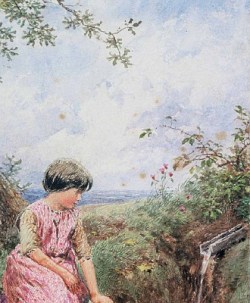
Detail of Birket Foster’s Girl with a
Pitcher showing evidence of foxing in
the sky area.
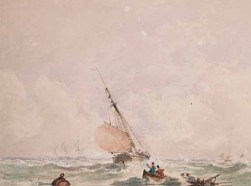
Detail of Copeley Fielding’s Off
Portsmouth.This work had suffered
light damage before it entered the
collection.White spots were evident
in the sky area because of pigment
discolouration and there was a tear
on the right edge of the paper.
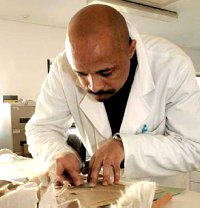
Paper restorer Keith Seaford removing
acidic backing board with a scalpel.
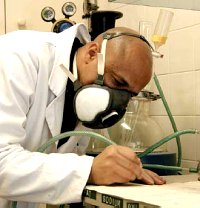
Treatment with Chlorine dioxide.
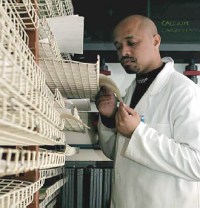
Inspecting restored paper works on
the drying racks after immersion in
Sodium thiosulphate solution.
|